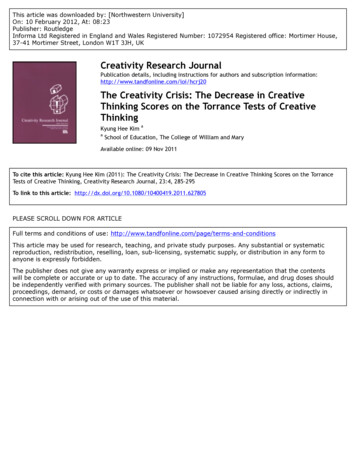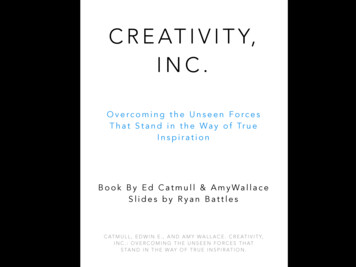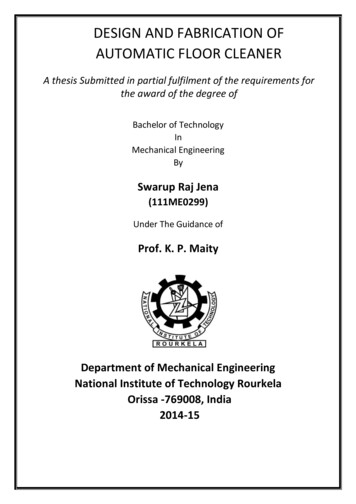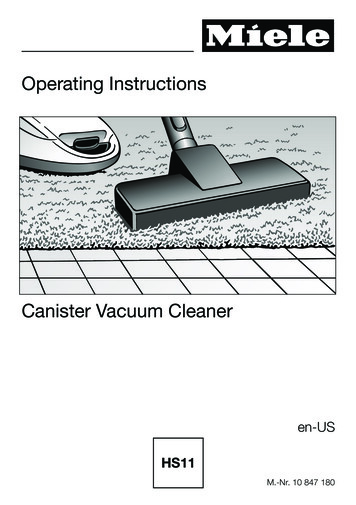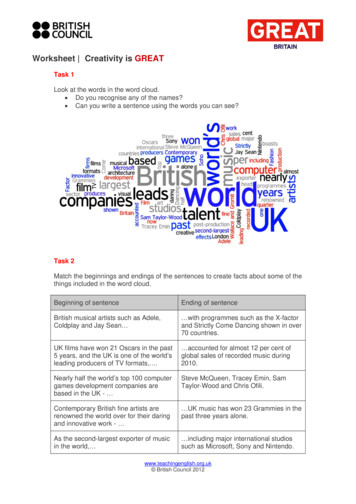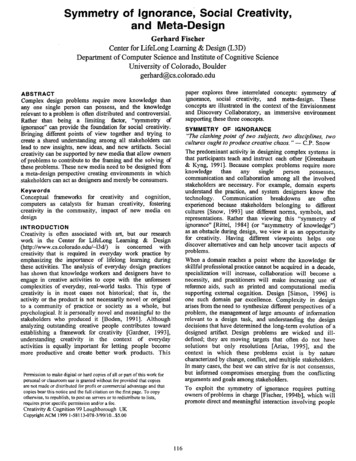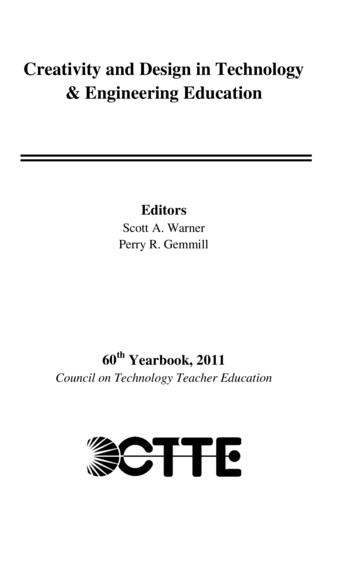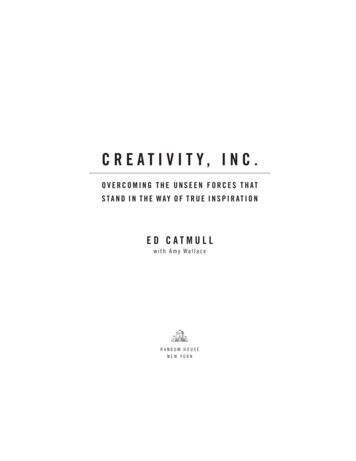
Transcription
C R E AT I V I T Y, I N C .O V E R C O M I N G T H E U N S E E N F O R C E S T H ATS T A N D I N T H E W AY O F T R U E I N S P I R A T I O NED CATMULLwith Amy WallacedRANDOM HOUSENEW YORKCatm 9780812993011 3p all r1.j.indd iii1/29/14 1:02 PM
Copyright 2014 by Edwin CatmullAll rights reserved.Published in the United States by Random House,an imprint and division of Random House LLC,a Penguin Random House Company, New York.Random House and the House colophon are registeredtrademarks of Random House LLC.library of congress cataloging-in-publication dataCatmull, Edwin E.Creativity, Inc. : overcoming the unseen forces that stand in the way oftrue inspiration / Ed Catmull with Amy Wallace.pages cmISBN 978-0-8129-9301-1eBook ISBN 978-0-679-64450-71. Creative ability in business. 2. Corporate culture. 3. Organizationaleffectiveness. 4. Pixar (Firm) I. Wallace, Amy. II. Title.HD53.C394 2014658.4'0714—dc23 2013036026Printed in the United States of America on acid-free paperwww.atrandom.com246897531first editionBook design by Diane HobbingCatm 9780812993011 3p all r4.r.indd iv2/14/14 11:35 AM
INTRODUCTION: LOST AND FOUNDEvery morning, as I walk into Pixar Animation Studios—past thetwenty-foot-high sculpture of Luxo Jr., our friendly desk lampmascot, through the double doors and into a spectacular glassceilinged atrium where a man-sized Buzz Lightyear and Woody,made entirely of Lego bricks, stand at attention, up the stairs pastsketches and paintings of the characters that have populated ourfourteen films—I am struck by the unique culture that defines thisplace. Although I’ve made this walk thousands of times, it nevergets old.Built on the site of a former cannery, Pixar’s fifteen-acre campus, just over the Bay Bridge from San Francisco, was designed,inside and out, by Steve Jobs. (Its name, in fact, is The Steve JobsBuilding.) It has well-thought-out patterns of entry and egress thatencourage people to mingle, meet, and communicate. Outside,there is a soccer field, a volleyball court, a swimming pool, and asix-hundred-seat amphitheater. Sometimes visitors misunderstandthe place, thinking it’s fancy for fancy’s sake. What they miss isthat the unifying idea for this building isn’t luxury but community.Steve wanted the building to support our work by enhancing ourability to collaborate.Catm 9780812993011 3p all r1.j.indd ix1/29/14 1:02 PM
x INTRODUCTION: LOST AND FOUNDThe animators who work here are free to—no, encouragedto—decorate their work spaces in whatever style they wish. Theyspend their days inside pink dollhouses whose ceilings are hungwith miniature chandeliers, tiki huts made of real bamboo, andcastles whose meticulously painted, fifteen-foot-high styrofoamturrets appear to be carved from stone. Annual company traditionsinclude “Pixarpalooza,” where our in-house rock bands battle fordominance, shredding their hearts out on stages we erect on ourfront lawn.The point is, we value self-expression here. This tends to makea big impression on visitors, who often tell me that the experienceof walking into Pixar leaves them feeling a little wistful, like something is missing in their work lives—a palpable energy, a feeling ofcollaboration and unfettered creativity, a sense, not to be corny, ofpossibility. I respond by telling them that the feeling they are picking up on—call it exuberance or irreverence, even whimsy—is integral to our success.But it’s not what makes Pixar special.What makes Pixar special is that we acknowledge we will always have problems, many of them hidden from our view; that wework hard to uncover these problems, even if doing so means making ourselves uncomfortable; and that, when we come across aproblem, we marshal all of our energies to solve it. This, more thanany elaborate party or turreted workstation, is why I love comingto work in the morning. It is what motivates me and gives me adefinite sense of mission.There was a time, however, when my purpose here felt a lot lessclear to me. And it might surprise you when I tell you when.On November 22, 1995, Toy Story debuted in America’s theatersand became the largest Thanksgiving opening in history. Criticsheralded it as “inventive” (Time), “brilliant” and “exultantly witty”(The New York Times), and “visionary” (Chicago Sun-Times). ToCatm 9780812993011 3p all r1.j.indd x1/29/14 1:02 PM
INTRODUCTION: LOST AND FOUND xifind a movie worthy of comparison, wrote The Washington Post,one had to go back to 1939, to The Wizard of Oz.The making of Toy Story—the first feature film to be animatedentirely on a computer—had required every ounce of our tenacity,artistry, technical wizardry, and endurance. The hundred or so menand women who produced it had weathered countless ups anddowns as well as the ever-present, hair-raising knowledge that oursurvival depended on this 80-minute experiment. For five straightyears, we’d fought to do Toy Story our way. We’d resisted the adviceof Disney executives who believed that since they’d had such success with musicals, we too should fill our movie with songs. We’drebooted the story completely, more than once, to make sure it rangtrue. We’d worked nights, weekends, and holidays—mostly without complaint. Despite being novice filmmakers at a fledgling studio in dire financial straits, we had put our faith in a simple idea: Ifwe made something that we wanted to see, others would want tosee it, too. For so long, it felt like we had been pushing that rock upthe hill, trying to do the impossible. There were plenty of momentswhen the future of Pixar was in doubt. Now, we were suddenlybeing held up as an example of what could happen when artiststrusted their guts.Toy Story went on to become the top-grossing film of the yearand would earn 358 million worldwide. But it wasn’t just the numbers that made us proud; money, after all, is just one measure of athriving company and usually not the most meaningful one. No,what I found gratifying was what we’d created. Review after reviewfocused on the film’s moving plotline and its rich, three-dimensionalcharacters—only briefly mentioning, almost as an aside, that it hadbeen made on a computer. While there was much innovation thatenabled our work, we had not let the technology overwhelm ourreal purpose: making a great film.On a personal level, Toy Story represented the fulfillment of agoal I had pursued for more than two decades and had dreamedabout since I was a boy. Growing up in the 1950s, I had yearned toCatm 9780812993011 3p all r1.j.indd xi1/29/14 1:02 PM
xii INTRODUCTION: LOST AND FOUNDbe a Disney animator but had no idea how to go about it. Instinctively, I realize now, I embraced computer graphics—then a newfield—as a means of pursuing that dream. If I couldn’t animate byhand, there had to be another way. In graduate school, I’d quietlyset a goal of making the first computer-animated feature film, andI’d worked tirelessly for twenty years to accomplish it.Now, the goal that had been a driving force in my life had beenreached, and there was an enormous sense of relief and exhilaration—at least at first. In the wake of Toy Story’s release, we tookthe company public, raising the kind of money that would ensureour future as an independent production house, and began workon two new feature-length projects, A Bug’s Life and Toy Story 2.Everything was going our way, and yet I felt adrift. In fulfilling agoal, I had lost some essential framework. Is this really what I wantto do? I began asking myself. The doubts surprised and confusedme, and I kept them to myself. I had served as Pixar’s president formost of the company’s existence. I loved the place and everythingthat it stood for. Still, I couldn’t deny that achieving the goal thathad defined my professional life had left me without one. Is this allthere is? I wondered. Is it time for a new challenge?It wasn’t that I thought Pixar had “arrived” or that my workwas done. I knew there were major obstacles in front of us. Thecompany was growing quickly, with lots of shareholders to please,and we were racing to put two new films into production. Therewas, in short, plenty to occupy my working hours. But my internalsense of purpose—the thing that had led me to sleep on the floor ofthe computer lab in graduate school just to get more hours on themainframe, that kept me awake at night, as a kid, solving puzzlesin my head, that fueled my every workday—had gone missing. I’dspent two decades building a train and laying its track. Now, thethought of merely driving it struck me as a far less interesting task.Was making one film after another enough to engage me? I wondered. What would be my organizing principle now?It would take a full year for the answer to emerge.Catm 9780812993011 3p all r1.j.indd xii1/29/14 1:02 PM
INTRODUCTION: LOST AND FOUND xiiiFrom the start, my professional life seemed destined to have onefoot in Silicon Valley and the other in Hollywood. I first got intothe film business in 1979 when, flush from the success of Star Wars,George Lucas hired me to help him bring high technology into thefilm industry. But he wasn’t based in Los Angeles. Instead, he’dfounded his company, Lucasfilm, at the north end of the San Francisco Bay. Our offices were located in San Rafael, about an hour’sdrive from Palo Alto, the heart of Silicon Valley—a moniker thatwas just gaining traction then, as the semiconductor and computer industries took off. That proximity gave me a front-rowseat from which to observe the many emerging hardware and software companies—not to mention the growing venture capitalindustry—that, in the course of a few years, would come to dominate Silicon Valley from its perch on Sand Hill Road.I couldn’t have arrived at a more dynamic and volatile time. Iwatched as many startups burned bright with success—and thenflamed out. My mandate at Lucasfilm—to merge moviemakingwith technology—meant that I rubbed shoulders with the leadersof places like Sun Microsystems and Silicon Graphics and CrayComputer, several of whom I came to know well. I was first andforemost a scientist then, not a manager, so I watched these guysclosely, hoping to learn from the trajectories their companies followed. Gradually, a pattern began to emerge: Someone had a creative idea, obtained funding, brought on a lot of smart people, anddeveloped and sold a product that got a boatload of attention. Thatinitial success begat more success, luring the best engineers and attracting customers who had interesting and high-profile problemsto solve. As these companies grew, much was written about theirparadigm-shifting approaches, and when their CEOs inevitablylanded on the cover of Fortune magazine, they were heralded as“Titans of the New.” I especially remember the confidence. Theleaders of these companies radiated supreme confidence. Surely,they could only have reached this apex by being very, very good.Catm 9780812993011 3p all r1.j.indd xiii1/29/14 1:02 PM
xiv INTRODUCTION: LOST AND FOUNDBut then those companies did something stupid—not juststupid-in-retrospect, but obvious-at-the-time stupid. I wanted tounderstand why. What was causing smart people to make decisionsthat sent their companies off the rails? I didn’t doubt that they believed they were doing the right thing, but something was blindingthem—and keeping them from seeing the problems that threatenedto upend them. As a result, their companies expanded like bubbles,then burst. What interested me was not that companies rose andfell or that the landscape continually shifted as technology changedbut that the leaders of these companies seemed so focused on thecompetition that they never developed any deep introspectionabout other destructive forces that were at work.Over the years, as Pixar struggled to find its way—first sellinghardware, then software, then making animated short films andadvertisements—I asked myself: If Pixar is ever successful, will wedo something stupid, too? Can paying careful attention to the missteps of others help us be more alert to our own? Or is there something about becoming a leader that makes you blind to the thingsthat threaten the well-being of your enterprise? Clearly, somethingwas causing a dangerous disconnect at many smart, creative companies. What, exactly, was a mystery—and one I was determined tofigure out.In the difficult year after Toy Story’s debut, I came to realizethat trying to solve this mystery would be my next challenge. Mydesire to protect Pixar from the forces that ruin so many businessesgave me renewed focus. I began to see my role as a leader moreclearly. I would devote myself to learning how to build not just asuccessful company but a sustainable creative culture. As I turnedmy attention from solving technical problems to engaging with thephilosophy of sound management, I was excited once again—andsure that our second act could be as exhilarating as our first.Catm 9780812993011 3p all r1.j.indd xiv1/29/14 1:02 PM
INTRODUCTION: LOST AND FOUND xvIt has always been my goal to create a culture at Pixar that willoutlast its founding leaders—Steve, John Lasseter, and me. But it isalso my goal to share our underlying philosophies with other leaders and, frankly, with anyone who wrestles with the competing—but necessarily complementary—forces of art and commerce. Whatyou’re holding in your hands, then, is an attempt to put down onpaper my best ideas about how we built the culture that is the bedrock of this place.This book isn’t just for Pixar people, entertainment executives,or animators. It is for anyone who wants to work in an environment that fosters creativity and problem solving. My belief is thatgood leadership can help creative people stay on the path to excellence no matter what business they’re in. My aim at Pixar—and atDisney Animation, which my longtime partner John Lasseter and Ihave also led since the Walt Disney Company acquired Pixar in2006—has been to enable our people to do their best work. Westart from the presumption that our peopl
Creativity, Inc. : overcoming the unseen forces that stand in the way of true inspiration / Ed Catmull with Amy Wallace. pages cm ISBN 978- 0- 8129- 9301- 1 eBook ISBN 978- 0- 679- 64450- 7 1. Creative ability in business. 2. Corporate culture. 3. Organizational effectiveness. 4. Pixar (Firm) I. Wallace, Amy. II. Title. HD53.C394 2014 658.4'0714— dc23 2013036026 Printed in the United States .
